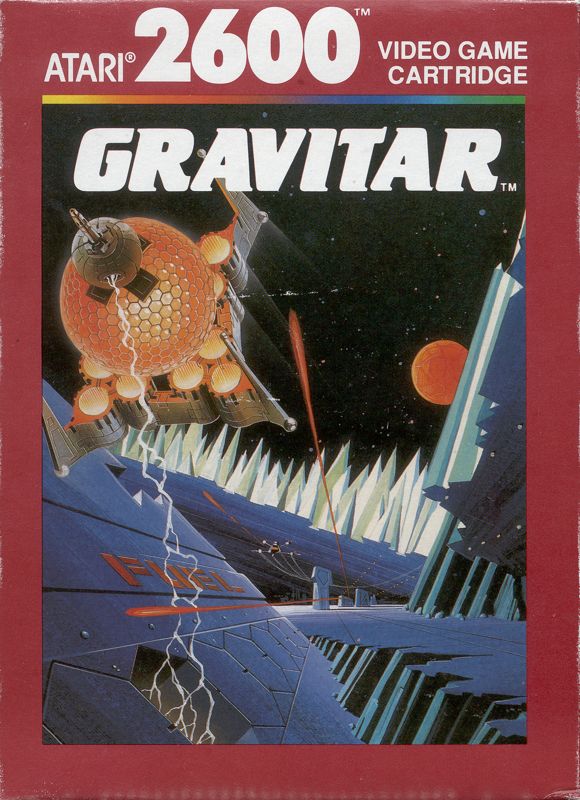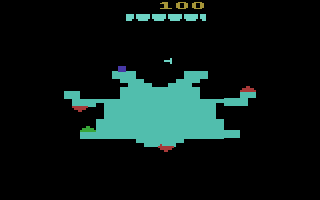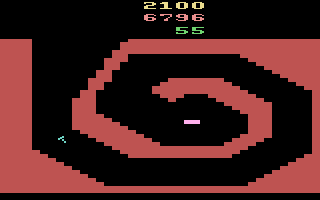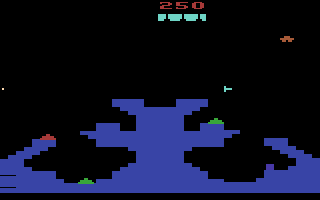Retro Replay Review
Gameplay
Gravitar’s gameplay centers around precise ship control and mastering variable gravitational pulls. As the pilot against the evil Gravitar, you navigate treacherous landscapes on hostile planets and within reactor cores. You must carefully modulate your thrust to hover against powerful gravity wells, land safely, and fire on enemy bunkers without crashing. The physics-driven movement rewards patience, gradual learning, and strategic planning.
(HEY YOU!! We hope you enjoy! We try not to run ads. So basically, this is a very expensive hobby running this site. Please consider joining us for updates, forums, and more. Network w/ us to make some cash or friends while retro gaming, and you can win some free retro games for posting. Okay, carry on 👍)
Each solar system presents a branching choice: either obliterate all the bunkers scattered across its three or four planets or infiltrate the alien reactor base and trigger a self-destruct sequence. Both approaches offer unique challenges. Planetary missions demand landing stability and bunker accuracy, while reactor runs are intense, time-limited sprints fraught with narrow corridors and explosive backlash. This dual-path structure keeps the gameplay fresh, encouraging experimentation.
The difficulty curve is notably steep but adjustable through five skill levels. Beginners can start with more ships and weaker gravity, easing into the game’s demands. Seasoned pilots will find the highest levels almost masochistic, with minimal margin for error and punishing gravitational forces that pull you into rocky terrain the moment you let your guard down. This scalability ensures Gravitar remains accessible and endlessly replayable.
Beyond the primary objectives, secondary factors enrich the experience: fuel management, strategic use of warp zones between galaxies, and mastering the nuances of horizontal versus vertical thrust. Your remaining ships and score carry over, adding tension to each decision—should you risk a bunker rush for extra points or play it safe for a guaranteed reactor detonation? These layered choices make every mission feel consequential.
Graphics
Gravitar sports crisp vector-based visuals, a hallmark of early-1980s arcade machines. The stark, wireframe landscapes convey planetary terrain, bunkers, and reactor interiors with minimalist clarity. While monochromatic at its core, the game often used colored overlays in arcade cabinets to differentiate sunlit backgrounds from the dark void of space, adding an unexpected vibrancy despite the simple line art.
The vector lines are remarkably smooth for their era, allowing you to precisely judge distances and gravitational arcs as you pilot your ship. Enemy bunkers and reactor details are rendered clearly enough to distinguish targets even at high speeds. Explosions, though basic, pulse in sharp intensity, providing immediate visual feedback when you’ve struck your mark or triggered the reactor’s core.
Animations are purposeful and functional rather than ornate. Your ship’s thrusters flare in real time, gravity fields shimmer subtly, and the reactor’s self-destruct sequence flashes warning lights before detonation. These effects, while modest by modern standards, heighten the suspense and underscore the game’s relentless pace.
In a retro context, Gravitar’s visuals hold up as an exercise in clarity over complexity. Every element on screen serves the gameplay, and the minimalist aesthetic complements the precision required to conquer each solar system. For contemporary players seeking nostalgia or an appreciation of vector art, Gravitar presents a timeless graphical style.
Story
At its heart, Gravitar tells a straightforward yet compelling narrative: a malevolent entity known simply as Gravitar is bent on universal domination. With each conquered galaxy, Gravitar strengthens gravitational fields, erects deadly bunkers, and powers volatile reactors—escalating the threat. Your mission, as the lone interstellar pilot, is to peel back these layers of cosmic tyranny one solar system at a time.
Though the storyline is conveyed primarily through the introductory premise rather than in-game cutscenes or dialogue, it drives the sense of urgency. Each reactor you sabotage brings you closer to Gravitar’s core. The absence of exposition during play focuses attention squarely on your actions, making every successful bunker demolition or reactor overload feel like a tangible victory in the galactic campaign.
The progression through four distinct galaxies underscores a rising stakes narrative. Early levels introduce manageable gravity and bunker layouts, but later systems are cloaked in oppressive gravity wells and labyrinthine reactor tunnels. This organic escalation mirrors Gravitar’s tightening grip on the cosmos, reinforcing the story’s momentum through ever-increasing gameplay intensity.
By combining minimalist lore with hands-on combat, Gravitar crafts an immersive storyline without narrative fluff. Players infer Gravitar’s growing power through environmental hazards and level difficulty rather than exposition, a storytelling approach that champions interactive tension over cutscene drama.
Overall Experience
Gravitar remains a benchmark of gravity-based arcade action. Its demanding controls and steep learning curve deliver a high-adrenaline experience that rewards perseverance and precision. Casual players may find the challenge daunting at first, but those willing to master the thrust-and-gravity mechanics will uncover a richly tactical shooter with deep replay value.
The game’s modular structure—offering planetary bunker hunts or reactor infiltration—gives you agency in how to tackle each system. Combined with adjustable skill levels, Gravitar caters to both newcomers and hardcore arcade veterans. Each mission feels distinct, and the satisfaction of witnessing a reactor’s final explosion never grows old.
While modern gamers accustomed to flashy graphics and narrative cutscenes may be surprised by Gravitar’s austere presentation, the iconic vector visuals and spot-on feedback loop remain compelling. The pure focus on gameplay mechanics is refreshing, stripping away unnecessary bells and whistles to emphasize player skill.
For potential buyers, Gravitar represents a piece of gaming history with surprisingly robust mechanics that still challenge and engage. Whether you’re chasing high scores, mastering gravity puzzles, or simply exploring classic arcade design, Gravitar offers an experience that is as punishing as it is rewarding. Strap in, steady your thrusters, and prepare to liberate twelve solar systems from the iron grip of Gravitar himself.
 Retro Replay Retro Replay gaming reviews, news, emulation, geek stuff and more!
Retro Replay Retro Replay gaming reviews, news, emulation, geek stuff and more!









Reviews
There are no reviews yet.